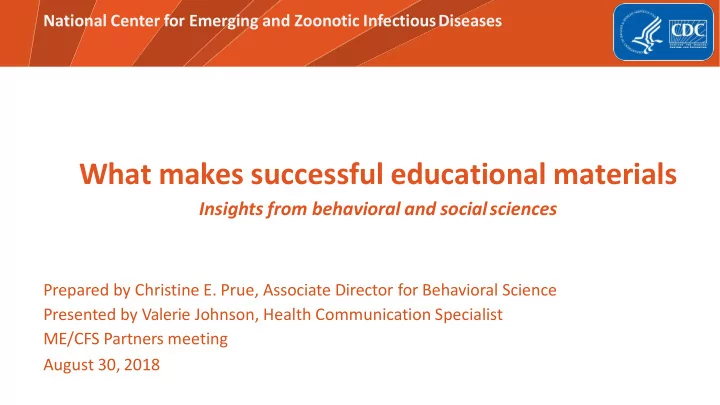

National Center for Emerging and Zoonotic InfectiousDiseases What makes successful educational materials Insights from behavioral and socialsciences Prepared by Christine E. Prue, Associate Director for Behavioral Science Presented by Valerie Johnson, Health Communication Specialist ME/CFS Partners meeting August 30, 2018
Objectives Describe the communication science and behavioral science that underpin CDC’s approach to developing educational materials. Describe the steps that CDC communicators and educators take to ensure materials are effective. Introduce CDC’s Clear Communication Index – a science- based tool that you can use to develop more effective educational materials.
Key decisions educators and communicators make every day Who is my primary audience? Why do I need to educate/communicate with them? What do I want/need to tell them? What is the best manner to tell them? What is the best medium to tell them? How will I reach my primary audience? How will I get feedback?
Communication and behavioral science can help you navigate these decisions Stay focused on destination Prioritize audience needs Minimize detours or distractions
Commonly Used Communication Theories or Models McGuire’s Hierarchy of Elaboration Likelihood Model Communication Effects Crisis and Emergency Risk SMCR Model of Communication Communication Model Consumer Information Processing Network Theory (social networks) Social Marketing Theory Extended Parallel Process Model (how attitudes are formed when fear Uses and Gratification Theory appeals are used) Agenda Setting Theory Knowledge Gap Theory
Commonly Used Health Behavior Theories or Models • Stages of Change (Trans-theoretical Model) • Precaution Adoption Process Model • Health Belief Model • Integrated Behavioral Model • Theory of Planned Behavior/Theory of • Common Sense Model (Illness Reasoned Action Representation Model) • Social Cognitive Theory/Social Learning • Transactional Model of Stress and Coping Theory • Community Organization • COM-B Model • PRECEDE-PROCEED • Social Marketing Theory • Social Ecological Model • Diffusion of Innovation • Behavioral Ecological Model
McGuire’s Hierarchy of Communication Effects Inputs: Source Message Channel Receiver Destination Outputs: 1. Exposure 2. Attending 3. Liking 4. Comprehending 5. Acquiringskills 6. Yielding 7. Remembering 8. Seeking information 9. Deciding 10. Behaving 11. Reinforcing 12. Consolidating
McGuire’s Hierarchy used in CDC’s VERB campaign
Health Belief Model Perceived susceptibility. Perceived barriers. Perceived severity. Self-efficacy. Perceived benefits. Cues to action.
Health Belief Model used in rabies education Perceived susceptibility. I don’t think I’ll ever get infected with rabies. Perceived severity. If I am infected with rabies, I could die. Perceived benefits. If I wash the wound and get care right away, I can survive. Perceived barriers. It is easier to kill the dog than observe it for 14 days. Self-efficacy. I am confident I can protect myself from rabies if I’m bitten by a dog.
Health Belief Model: Cues to action
How CDC ensures that education and communication efforts are effective https://www.cdc.gov/ccindex/
Steps CDC takes to ensure that education and communication efforts are effective 1. Select an audience 2. State a clear communication objective 3. Engage youraudience 4. Design with the audience in mind 5. Pre-test your material and revise based on feedback 6. Produce, place, and promote them
Clear Communication Index covers Steps 1 ꟷ 4: 1. Select an audience 2. State a clear communication objective 3. Engage your audience 4. Design with the audience in mind https://www.cdc.gov/ccindex/
How to get and keep your audience’s attention Have a main message that is prominent and portrayed graphically or visually Include specific calls to action or make behavioral recommendations Use language and numbers that your audience’s uses Chunk and layer information so your audience can easily find what they are looking for https://www.cdc.gov/ccindex/ https://www.cdc.gov/me-cfs/p dfs/me-cfs-children-parents.pdf
New audience means New main message and photo New calls to action New words https://www.cdc.gov/me -cfs/pdfs/me-cfs-children-educators.pdf
New audience means New main message and photo New calls to action New words https://www.cdc.gov/me-cfs/me-cfs-children/factsheet-healthcare-professional.html
5. Pre-test your material with your audience and revise based on feedback This step can be done multiple times, if needed. Interviewing Observation “What people say and what people do Contextual Inquiry and what they say they do are entirely different things. ” Walk-a-mile --Margaret Mead, Anthropologist
6. Produce, place, and promote your material “If you build it, they will come!” only happens in the movies Use audience insights to place your materials where your audience will most likely encounter it. Promote your material with the audience and with people or organizations whom your audience trusts and respects.
Recap: The steps that make education and communication effective 1. Select an audience 2. State a clear purpose 3. Engage youraudience 4. Design with the audience in mind 5. Pre-test your material and revise based on feedback 6. Produce, place, and promote them
Christine E. Prue, MSPH, PhD cprue@cdc.gov Valerie Johnson, MPH, CHES vjohnson@cdc.gov For more information, contact CDC 1-800-CDC-INFO (232-4636) TTY: 1-888-232-6348 www.cdc.gov The findings and conclusions in this report are those of the authors and do not necessarily represent the official position of the Centers for Disease Control and Prevention.
Recommend
More recommend